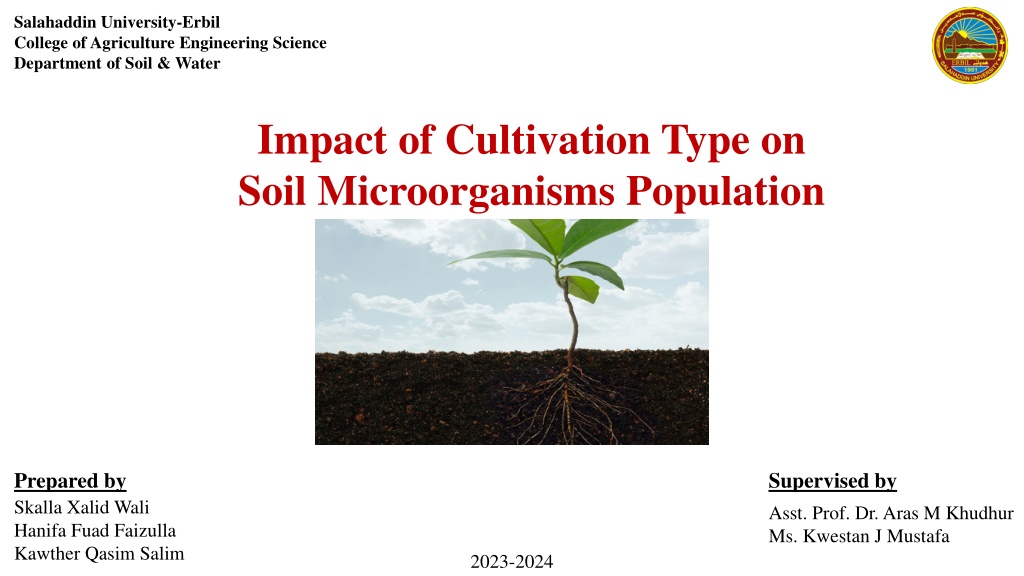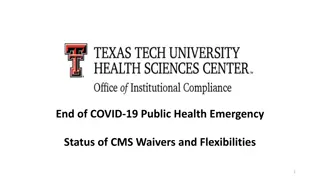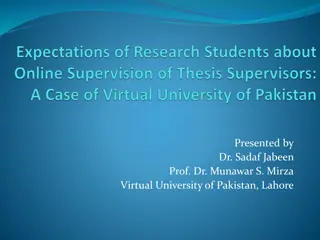
Impact of Cultivation Type on Soil Microorganisms Population Study
Explore the impact of different plant types on soil microorganisms population in this study conducted by Salahaddin University-Erbil. Discover how cultivation type affects soil properties and nutrient cycles, showcasing significant variations among plant root exudates and their influence on total soil microorganisms.
Download Presentation

Please find below an Image/Link to download the presentation.
The content on the website is provided AS IS for your information and personal use only. It may not be sold, licensed, or shared on other websites without obtaining consent from the author. Download presentation by click this link. If you encounter any issues during the download, it is possible that the publisher has removed the file from their server.
E N D
Presentation Transcript
Salahaddin University-Erbil College of Agriculture Engineering Science Department of Soil & Water Impact of Cultivation Type on Soil Microorganisms Population Prepared by Supervised by Asst. Prof. Dr. Aras M Khudhur Ms. Kwestan J Mustafa Skalla Xalid Wali Hanifa Fuad Faizulla Kawther Qasim Salim 2023-2024
Introduction Soil Microorganisms constitute < 0.5% (w/w) of the soil mass, yet they have a major impact on soil properties and processes. About 60-80% of the total soil metabolism is due to microflora. these are the smallest organisms (<0.1mm in diameter) and are extremely abundant and divers they include: algae, bacteria, cyanobacteria, fungi, yeasts, and actinomycetes. Microorganisms in soil play major role in the conversion of organic matter and nutrient cycle. The biological system of the soil responds sensitively to environmental changes, especially to the loss of organic matter, which can be caused by soil cultivation.
We put 20g of media in 1L of Distilled water. Preparation of Culture Media We're going to mixing it well. Take the media of the autoclave at 121C for 15 minutes and put it in the petri dish.
Isolation Soil Microorganism 1.In the third, Fourth and Fifth test tube, We take a 1ml of solution and take it on the petri dishes. 2. After that we put the solution in the petri dish and put them in the incubator at 28C for 72h. 3.After a while, When we take out the petri dishes, we see that all the colony is built on it. Each of these colony describes a microorganism.
Plant Rhizosphere Zone Bean No. of Soil Microorganisms 124.25 * 10^4 Barley 186 * 10^4 Result Strawberry 149.25 * 10^4 Corn 109 * 10^4 Control(without plant) 99.25 * 10^4 LSD(0.01) 12.33
Conclusion Conclusion From this study on the effect of different plant types (Bean, Barley, Strawberry, Corn) on total soil Microorganisms showed that plant types have sighnificant effects on total soil microorganisms, this may be due to the difference among plant root exudates.
References Doran, J.W. 1980. Soil microbial and biochemical changes associated with reduced tillage. Soil Science Society of America Journal, 44(4), pp.765-771. Pabar, S.A., M nok, D., Kotrocz , Z. & Bir , B. 2020. Soil microbial parameters and synergies between bean growth and microbial inoculums as a dependence of five soils with different characteristics. HUNGARIAN AGRICULTURAL ENGINEERING, (37), pp.27-33. Ch, T.A.2020, Soil Microbial biomass, dehydrogenases activity, bacteria community structure to long-term biofertlizer, Soil Biol. Biochem, 39,pp.2971-2976.






















